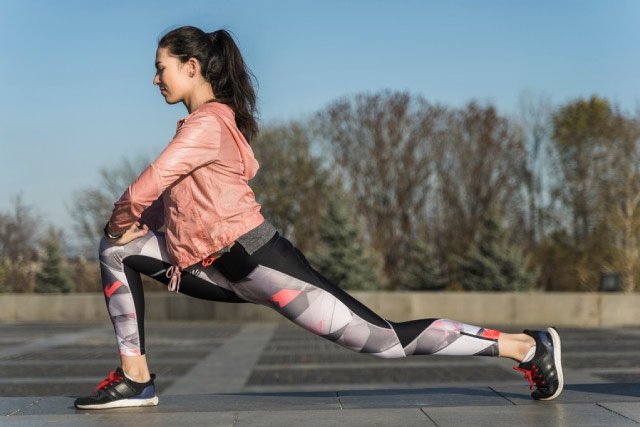
Running, a simple yet highly effective exercise, has been a cornerstone of fitness routines for decades. Many individuals have found immense benefits in incorporating running into their daily lives. In this article, we will delve into the advantages of running 5 miles a day and explore various aspects to consider for a fulfilling running experience.
1. Health Benefits of Running 5 Miles a Day

1.1. Physical Health
Running 5 miles a day offers a myriad of physical health benefits. From improving cardiovascular health to enhancing lung capacity, the positive impact on the body is substantial. The rhythmic motion of running engages various muscle groups, contributing to overall strength and flexibility.
1.2. Mental Well-being
Beyond physical health, the mental benefits of a daily 5-mile run are equally significant. Running has been linked to stress reduction, improved mood, and increased cognitive function. It serves as an effective way to improve spiritual wellness and boost mental resilience.
2. Getting Started

2.1. Proper Warm-up
Before embarking on a 5-mile run, a proper warm-up is crucial. Dynamic stretches and light cardio prepare the muscles for the upcoming exertion, reducing the risk of injuries.
Steps:
- Start with light jogging in place for 5 minutes.
- Perform dynamic stretches such as leg swings and arm circles.
- Gradually increase the intensity of stretches to elevate heart rate.
2.2. Choosing the Right Footwear
Investing in quality running shoes tailored to your foot type is essential. The proper footwear provides adequate support, minimizing the impact on joints and ensuring a comfortable run.
Considerations:
- Visit a specialized store for a professional fitting.
- Replace running shoes every 300-500 miles or when signs of wear appear.
3. Setting Realistic Goals

3.1. Gradual Progress
Setting realistic running goals is key to a sustainable routine. Begin with shorter distances and gradually increase as your stamina improves. This approach minimizes the risk of burnout and injuries.
Tips:
- Start with 1-2 mile runs and add 10% distance each week.
- Listen to your body and adjust the pace accordingly.
3.2. Tracking Milestones
Tracking your running milestones not only provides a sense of accomplishment but also helps in adjusting your goals. Whether improving your pace or conquering challenging terrains, celebrating milestones keeps the motivation high.
Tools:
- Use running apps to track distance, pace, and achievements.
- Maintain a running journal to log personal milestones and experiences.
4. Nutritional Considerations

4.1. Pre-run Nutrition
Fueling your body with the proper nutrients before a run is vital. Opt for a balanced meal containing carbohydrates, proteins, and healthy fats to sustain energy levels throughout the run.
Suggestions:
- Consume a meal 2-3 hours before running.
- Include complex carbs like whole grains and lean proteins.
4.2. Post-run Nutrition
Post-run nutrition is equally important for optimal health and wellness. Incorporate a mix of carbohydrates and proteins to replenish glycogen stores and promote muscle repair.
Options:
- A protein shake with a banana.
- Greek yogurt with granola and berries.
5. Avoiding Common Injuries

5.1. Stretching Techniques
Proper stretching techniques, both before and after a run, reduce the risk of injuries. Focus on dynamic stretches before running and static stretches afterward.
Routine:
- Dynamic stretches: Leg swings, high knees, arm circles.
- Static stretches: Hamstring stretch, calf stretch, quadriceps stretch.
5.2. Listening to Your Body
Understanding your body’s signals is crucial. If you experience persistent pain or discomfort, it’s essential to rest and consult with a healthcare professional if needed.
Signs to Watch:
- Sharp or prolonged pain.
- Swelling or inflammation.
- Fatigue that doesn’t improve with rest.
6. Variety in Running Routes

6.1. Trail Running
Exploring different running routes adds variety to your routine. Trail running, with its uneven terrain, provides an additional challenge that enhances strength and coordination to stay healthy.
Benefits:
- Engages stabilizing muscles.
- Connects you with nature for a refreshing experience.
6.2. Treadmill vs. Outdoor Running
While treadmills offer convenience, outdoor running exposes you to natural elements such as green therapy. Both have their advantages, so incorporating a mix keeps your routine interesting.
Pros and Cons:
- Treadmill: Controlled environment, impact absorption.
- Outdoor Running: Fresh air, varied terrain, and vitamin D exposure.
7. Staying Motivated

7.1. Joining Running Groups
Joining local running groups fosters a sense of community and motivation. The collective energy of a group can be a powerful catalyst for consistent running.
Benefits:
- Shared experiences and advice.
- Motivation through friendly competition.
7.2. Using Fitness Apps
Fitness apps can track your progress, offer personalized training plans, and provide a virtual community. They add a technological dimension to your running routine.
Recommended Apps:
- Strava for tracking and connecting with other runners.
- Nike Run Club for guided runs and personalized coaching.
8. Balancing Rest and Recovery

8.1. Importance of Rest Days
Rest days are not a sign of weakness but a crucial component of any fitness routine. They allow your body to recover and reduce the risk of overtraining.
Activities on Rest Days:
- Gentle yoga or stretching.
- Light activities like walking or swimming.
8.2. Incorporating Cross-Training
Cross-training activities like swimming or cycling complement running and prevent monotony. They engage different muscle groups, promoting overall fitness.
Cross-Training Ideas:
- Cycling for cardiovascular endurance.
- Strength training to build muscle and prevent imbalances.
9. Monitoring Progress

9.1. Wearable Fitness Technology
The use of wearable fitness technology provides real-time data on your performance. From heart rate monitoring to GPS tracking, these devices offer insights for continuous improvement.
Popular Wearables:
- Fitness trackers like Fitbit.
- Smartwatches with GPS capabilities.
9.2. Keeping a Running Journal
Maintaining a running journal allows you to reflect on your experiences, track emotions, and identify patterns. It becomes a personal record of your journey.
What to Include:
- Distance and time of each run.
- Weather conditions and how you felt during the run.
10. Overcoming Mental Barriers

10.1. Building a Positive Mindset
Running is not just a physical but also a mental challenge. Cultivating a positive mindset helps overcome mental barriers and push through challenging moments.
Strategies:
- Positive affirmations during runs.
- Visualization of achieving running goals.
10.2. Dealing with Plateaus
Plateaus are a natural part of any fitness journey. Instead of getting discouraged, view them as an opportunity to reassess and tweak your routine for continuous improvement.
Plateau-Busting Tips:
- Introduce interval training.
- Vary running routes to challenge different muscles.
11. Social and Community Aspects

11.1 Participating in Running Events
Participating in running events, whether local 5Ks or marathons, adds a social dimension to your running journey. The camaraderie among participants creates a memorable experience.
Preparation:
- Train specifically for the event distance.
- Enjoy the experience and celebrate the achievement.
11.2. Connecting with Other Runners
Connecting with fellow runners in person or through online communities provides a platform for sharing experiences, tips, and encouragement.
Online Platforms:
- Join running forums or social media groups.
- Share your achievements and seek advice when needed.
12. Running for a Cause

12.1. Charity Runs
Combining fitness and philanthropy, charity runs allow you to contribute to a cause while pursuing your fitness goals. It adds a meaningful aspect to your running routine.
Steps to Get Involved:
- Find local charity-run events.
- Create a fundraising page and share your goals.
13. Common Misconceptions

13.1. Myth: Running is Harmful to Knees
Dispelling common misconceptions about running, such as the belief that it harms knees, is essential. Running is generally safe and beneficial when done with proper form and technique.
Clarification:
- Proper footwear and form reduce impact.
- Consult with a professional if experiencing knee pain.
Conclusion
In conclusion, running 5 miles daily is a holistic fitness approach encompassing physical and mental well-being. By incorporating proper warm-ups, setting realistic goals, considering nutrition, and staying motivated, individuals can experience the full benefits of running.
FAQs
Is running 5 miles a day suitable for beginners?
While it may be challenging for beginners, starting with shorter distances and gradually increasing is a more sustainable approach.
How often should I change my running shoes?
Running shoes should be replaced every 300-500 miles or when they show signs of wear and tear.
Can I run 5 miles a day on a treadmill?
Running on a treadmill is a valid option, but incorporating outdoor runs adds variety to your routine.
What should I eat before a 5-mile run?
A balanced meal with carbohydrates and protein, consumed 2-3 hours before the run, provides adequate fuel.
How do I stay motivated during plateaus?
Switch up your routine, set new goals, or seek inspiration from fellow runners to overcome plateaus.








